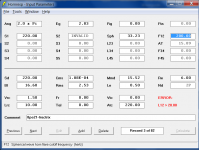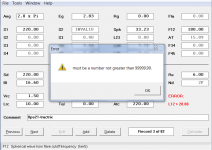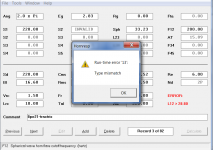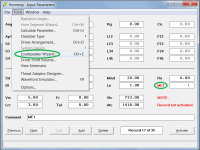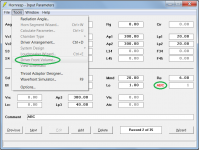mwmkravchenko, I don't think I'd call that one a bug. Maybe just a limitation.
Agreed. Why for I prefaced it with little bug. I like limitation much better!
Now that is an interesting find. How long has this little bug been living in the program?
Hi Mark,
For the Le Cléac'h flare, since Version 28.80, for the hyperbolic-exponential flare, since Version 36.20.
I noticed the problem when I posted the following message:
http://www.diyaudio.com/forums/full-range/254834-gemme-audio-vflex-magic-13.html#post4508526
Kind regards,
David
100,000cm^2 is quite a large mouth
100,000 cm^2 means that the horn mouth can be up to 10 metres x 10 metres square
No.100,000 cm^2 means that the horn mouth can be up to 10 metres x 10 metres square.
10m² = 100000cm² and that is ~ 3.1m by 3.2m
1Mcm² = 100m² = 10m by 10m
No.
10m² = 100000cm² and that is ~ 3.1m by 3.2m
1Mcm² = 100m² = 10m by 10m
Hi Andrew,
Thanks for picking this up.
I copied AllenB's figure of 100,000 cm² without thinking
The Hornresp limit of 999999.9 cm² is close enough to 1,000,000 cm² which is why I said that the horn mouth can be up to 10 m x 10 m.
AllenB blamed his "missing zero" on it being Friday afternoon when he posted his message
Kind regards,
David
Indeed it was, in fact I thought I had succumbed to the square cm vs cm squared notational error. In fact 99,999 (cm²) <-[paranoid nowAllenB blamed his "missing zero" on it being Friday afternoon when he posted his message.
Where the larger mouths have, and will help me is when comparing similar horns of differing frequencies where I want to eliminate ripple from the comparison. I went through a phase of analysing the LeCleach physical parameters against performance/limitations where this was helpful.
This reminds me of a question I have. All LeCleach horns seem to have a common factor that I can only best describe as them having almost the same slope on the beamwidth plot vs angle regardless of all other parameters. The Klugelwellen seems to break free of this. Is this type another name for the spherical horn, is it the answer to changing the beamwidth slope and how does it otherwise compare to the LeCleach?
Originally Posted by AllenB View Post
100,000cm^2 is quite a large mouth
100,000 cm^2 means that the horn mouth can be up to 10 metres x 10 metres square
This shows the flaw in using too many zeros when writing numbers.Hi Andrew,
Thanks for picking this up.
I copied AllenB's figure of 100,000 cm² without thinking.
The Hornresp limit of 999999.9 cm² is close enough to 1,000,000 cm² which is why I said that the horn mouth can be up to 10 m x 10 m.
AllenB blamed his "missing zero" on it being Friday afternoon when he posted his message.
Kind regards,
David
Make use of the multipliers that most of the Members know and understand.
There is nothing to be gained with many zeros in tiny numbers as in 0.00000000000267F where a multiplier makes for much easier typing and reading.
Nor does 10000000mm² help, when 10m² is much easier to read.
BTW, that capacitance was 2p67F if you can find someone to sell you that value.
Last edited:
I agree with you Andrew, and it was how I was trained.
The common ground with hornresp and the area boxes is they use floating variables and expect numerical input, and also given that I usually don't go too far in to the tens of thousands and I probably wouldn't feel comfortable typing 2k55 when I can type 2550 for eg. Current discussion is at the extremes of cross sectional areas.
Good example by the way, not too sure I haven't owned a 2pF capacitor at some point
The common ground with hornresp and the area boxes is they use floating variables and expect numerical input, and also given that I usually don't go too far in to the tens of thousands and I probably wouldn't feel comfortable typing 2k55 when I can type 2550 for eg. Current discussion is at the extremes of cross sectional areas.
Good example by the way, not too sure I haven't owned a 2pF capacitor at some point
The Klugelwellen seems to break free of this. Is this type another name for the spherical horn,
The Kugelwellen horn, invented by Klangfilm, is the spherical wave horn by another name.
Avantgarde Acoustic is one company that uses spherical wave horns.
There is nothing to be gained with many zeros in tiny numbers
That's why Hornresp formats the Cms value using scientific notation
C. D/click F12 -> Fatal.
Many thanks AllenB, an excellent find - I need to investigate.
Kind regards,
David
C. D/click F12 -> Fatal.
Hi AllenB,
I found the problem. It was inadvertently introduced in the last update, and will be fixed in the next release.
Thanks again and kind regards,
David
Glad to do what I can.
Humbly, I was suspecting something with the 'INVALID' string, it's something I've done enough. Not important though.
I've recently discovered that a schematic can be called up before a calculation using CTRL-Z, I updated from a June build and now there is an undo function. Excellent. Now CTRL-Z has been naturally reassigned.
Humbly, I was suspecting something with the 'INVALID' string, it's something I've done enough. Not important though.
I've recently discovered that a schematic can be called up before a calculation using CTRL-Z, I updated from a June build and now there is an undo function. Excellent. Now CTRL-Z has been naturally reassigned.
Hi AllenB,
The feature has been there since Version 5.00 . It enables the user to do a quick sanity check of a design before commencing calculations.
. It enables the user to do a quick sanity check of a design before commencing calculations.
It is now necessary to press keys Alt, T, V consecutively to preview the schematic diagram. The Tools > View Schematic menu command can also be used. Ctrl+Z is the standard Microsoft shortcut for the Undo function, so I thought it made more sense to use it for that purpose (along with Ctrl+Y for the Redo function).
Kind regards,
David
I've recently discovered that a schematic can be called up before a calculation using CTRL-Z,
The feature has been there since Version 5.00
I updated from a June build and now there is an undo function. Excellent. Now CTRL-Z has been naturally reassigned.
It is now necessary to press keys Alt, T, V consecutively to preview the schematic diagram. The Tools > View Schematic menu command can also be used. Ctrl+Z is the standard Microsoft shortcut for the Undo function, so I thought it made more sense to use it for that purpose (along with Ctrl+Y for the Redo function).
Kind regards,
David
Hornresp Update 3940 -151117
Hi Everyone,
CHANGE
Parts of the code have been refined to reduce the number of arithmetic operations required to simulate a design. The predicted results are the same, but in some cases calculation times may be slightly quicker.
BUG FIXES
For ME1 And ME2 records:
1. The schematic diagrams were sometimes incorrect when selected from the main Input Parameters window.
2. The Loudspeaker Wizard tool menu command was enabled in Edit mode. For the listed record types, it should not be possible to access this tool in Edit mode. Attachment 1 refers.
For BP6, BP8 and ABC records:
1. The Driver Front Volume tool menu command was disabled in Edit mode. For the listed record types, it should be possible to access this tool in Edit mode. Attachment 2 refers.
The above three bugs and the one reported by AllenB in Post #5832 have now been fixed.
Kind regards,
David
Hi Everyone,
CHANGE
Parts of the code have been refined to reduce the number of arithmetic operations required to simulate a design. The predicted results are the same, but in some cases calculation times may be slightly quicker.
BUG FIXES
For ME1 And ME2 records:
1. The schematic diagrams were sometimes incorrect when selected from the main Input Parameters window.
2. The Loudspeaker Wizard tool menu command was enabled in Edit mode. For the listed record types, it should not be possible to access this tool in Edit mode. Attachment 1 refers.
For BP6, BP8 and ABC records:
1. The Driver Front Volume tool menu command was disabled in Edit mode. For the listed record types, it should be possible to access this tool in Edit mode. Attachment 2 refers.
The above three bugs and the one reported by AllenB in Post #5832 have now been fixed.
Kind regards,
David
Attachments
I downloaded Hornresp to my new PC yesterday afternoon.
Today it tells me it is out of date.
So I accepted the new download.
Unzipped into the Hornresp folder.
But when I clicked on the shortcut, it still tells me that I have the 1112 version and it is out of date.
What have I done wrong?
Today it tells me it is out of date.
So I accepted the new download.
Unzipped into the Hornresp folder.
But when I clicked on the shortcut, it still tells me that I have the 1112 version and it is out of date.
What have I done wrong?
- Home
- Loudspeakers
- Subwoofers
- Hornresp
